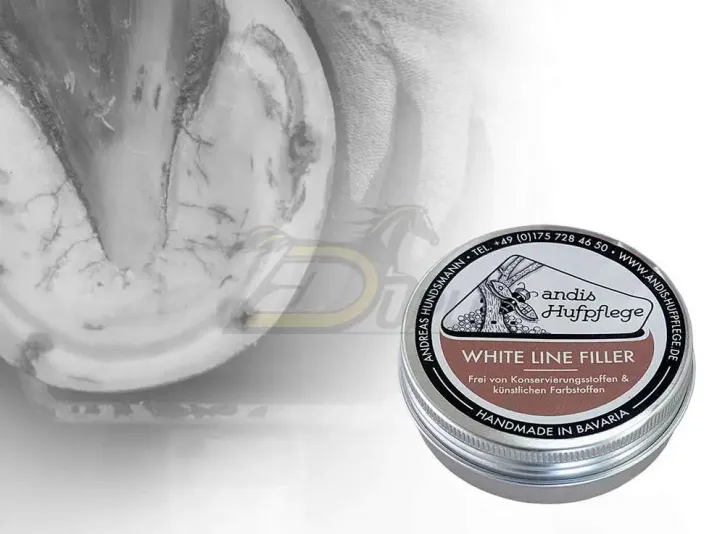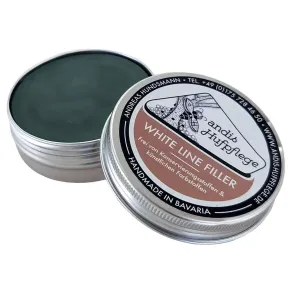White Line Filler — to fill eroded white lines
The structure of the horse's hoof is so complex that it would go beyond the scope of this text to go into more detail. When we talk about our composite horseshoes, we always like to talk about the interaction of hard and soft structures in the hoof and in the shoe. But this is really a very simplified view of the horses' footing.
Many of us are familiar with the saying "no hoof, no horse". Keeping the hoof healthy (whether barefoot or shod) requires a good hoof trimmer, the right hygiene and care routine during the shoeing period and often supportive care products - whether as a preventive measure or treatment of acute problems.
The hoof care products must be designed to suit the structure and function of the respective area of the horse's hoof. A product for a solid hoof wall, for example, is generally not suitable for the frog . Developing the right hoof care products for the individual areas of the hoof requires the appropriate specialist knowledge of their structure and function.
Andreas (andi) Hundsmann, the farrier behind andi's Hufpflege (hoof care), has been working as a state-approved farrier and farriery instructor since 2006. Based on his professional experience, he began producing organic quality hoof care products a few years ago. For him, it is important that his products are 100% natural and free from preservatives , artificial colorants, and petroleum based carriers.
These hoof care products include the White Line Filler, which was developed to fill in eroded white lines.
The White Line – Appearance and Function
The term "white line" is somewhat misleading, as it is not actually white but rather a light yellowish color. If it cannot be clearly identified by its color, it can be recognized by its distinctive structure. The white line extends from the toe of the hoof, along the quarters, all the way to the heel buttresses .
The appearance of the white line can provide insights into the condition of the suspensory apparatus of the hoof .In the case of laminitis , for example, the white line is usually much wider. For this reason, you should consult a vet if you notice any significant changes in the white line.
The white line is intended to act as a barrier and protect the suspensory apparatus against ascending germ contamination. However, it can often only perform its barrier function inadequately if, for example, defects between parts of the horn are visible. The defects can be caused, for example, by age-related differences between the lamellar horn and the terminal horn . The difference in age between the two horn materials is due to the fact that the lamellar horn has to travel a "longer distance" than the terminal horn before it reaches the bearing edge . Older horn has a lower water content and is therefore harder than younger horn. With the ageing process, the horn becomes harder and harder and ultimately more and more cracked.

Cracks and fissures in the horn, as well as signs of decay with black discoloration in this area, can result in the white line not being able to perform its function as a barrier properly, ultimately leading to the White Line Disease (loose wall). It is therefore important to always keep a close eye on the white line and to take care of it accordingly if there are porous or eroded areas.
Application and safety instructions when working with the White Line Filler
The products from andis Hufpflege are made from natural ingredients. However, to avoid potential risks during use, the manufacturer provides the following guidelines:
- Not suitable for open abscesses.
- Keep away from heat, hot surfaces, sparks, open flames, and other sources of ignition. Do not smoke.
- Not suitable for consumption.
- In case of contact with eyes, rinse thoroughly with water for several minutes.
- If skin irritation occurs, seek medical advice.
- Not suitable for use by children under 7 years old.
According to the manufacturer's instructions, the White Line Filler has a shelf life of 6 months once it
has been opened. Please ensure that the White Line Filler is not contaminated during use so that no
germs
get into it. If you want to be on the safe side, we therefore recommend wearing disposable gloves when
working with the White Line Filler.

When using the White Line Filler, make sure that the area to be treated is clean and dry before application.
To treat the eroded areas in the white line, take the required amount of White Line Filler, twist the mass together slightly with your fingers - like a kneading mass - and fill the corresponding areas in the white line with it. Please note that andis hoof care products should generally be applied in very sparing doses.
The White Line Filler can be used for horses that are barefoot as well as for those that are shod. It is suitable for use between the horseshoe and insole or for indirect gluing .
Ingredients
- beeswax
- Natural and essential oils
- natural resins
- color pigments
- Manuka honey
The White Line Filler is free from artificial colorants and preservatives and, like the other hoof care products from andis Hufpflege, is mixed by hand and bottled in Garmisch-Partenkirchen .
Ingredients with Special Qualities: Manuka Honey and Beeswax
We know that bees play a crucial role for all of us - but many of us think primarily of their role in food security. But bees are not only useful when it comes to the pollination of plants ; the production of beeswax and honey is also of immense importance to us. Beeswax, for example, is used in many ointments and creams as it forms a light protective film on the skin and has antibiotic properties, among other things. Honey is moisturizing and anti-inflammatory and also has an antimicrobial effect, which means that honey can help fight bacteria and prevent infections - properties that are particularly important when treating the damaged areas of the white line.
Manuka honey, produced by honeybees in New Zealand, is renowned for its unique properties due to its high levels of methylglyoxal (MGO) , making it a highly valued product worldwide. According to an article in GEO Magazine, commercial honey contains a maximum of 20 mg of MGO per kilogram, whereas Manuka honey contains between 300 and 800 mg of MGO. The higher the MGO content, the stronger the antibacterial effect of Manuka honey.
The White Line Filler from andis hoof care therefore scores points not only for its natural, but also particularly high-quality ingredients.

Product Features — White Line Filler
| Article | White Line Filler |
|---|---|
| produced by | Andreas Hundsmann — andis Hufpflege |
| Made in | Germany — "handmade in Bavaria" |
| Article Number | PAWL60 |
| Function | Hoof care product, for filling porous/crumbled white line |
| Ingredients | Beeswax, pure and essential oils, natural resins, natural color pigments, Manuka honey |
| Scope of Delivery | one can with 60 ml content |
| Storage | Store below 50°C (122°F) |
| Exchange and Return | Possible within 1 month within the EU under certain conditions. For returns outside the EU, please contact our Customer Service Team. You can find all the details under FAQ → Service & Conditions. |
Manufacturer in accordance with the Regulation (EU) 2023/988 on General Product Safety (GPSR)
Manufacturer in accordance with the Regulation (EU) 2023/988 on General Product Safety (GPSR)
Name: Andreas HundsmannElectronic Address: andis-hufpflege.de
Physical Address: Werdenfelser Str. 1
ZIP Code: 82467
City: Garmisch-Partenkirchen
Country: Deutschland
Phone: +49 (0)175 728 46 50
Responsible Person in accordance with the Regulation (EU) 2023/988 on General Product Safety (GPSR)
Name: Andreas HundsmannElectronic Address: info@andis-hufpflege.de
Physical Address: Werdenfelser Str. 1
ZIP Code: 82467
City: Garmisch-Partenkirchen
Country: Deutschland








